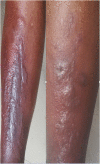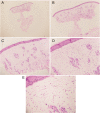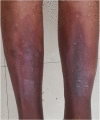Pretibial myxedema in a euthyroid patient: a case report
- PMID: 33648506
- PMCID: PMC7919313
- DOI: 10.1186/s13044-021-00096-z
Pretibial myxedema in a euthyroid patient: a case report
Abstract
Background: Pretibial myxedema also known as localized myxedema, thyroid dermopathy, or infiltrative dermopathy and rarely as localized mucinosis is an infrequent manifestation of Graves' disease. It can appear before, during, or after the thyrotoxic state. Euthyroid pretibial myxedema is a rare presentation with few case reports in the literature. This case highlights the importance of considering pretibial myxedema when characteristic skin lesions are observed in a euthyroid patient.
Case presentation: A 72-year old male Ethiopian patient with a very rare presentation of biopsy-proven pretibial myxedema in a euthyroid state without history of thyroid disease and absence of thyroid autoimmune markers. Resolution of skin lesion was achieved after topical corticosteroid application.
Conclusion: Absence of history of thyroid disorder and normal thyroid function tests should not exclude the diagnosis of pretibial myxedema.
Keywords: Euthyroid; Pretibial myxedema.
Conflict of interest statement
No financial and non-financial competing interests.
Figures



Similar articles
-
Euthyroid pretibial myxedema.Endocr Pract. 1998 Nov-Dec;4(6):375-7. doi: 10.4158/EP.4.6.375. Endocr Pract. 1998. PMID: 15251711
-
Pretibial myxedema: pathophysiology and treatment options.Am J Clin Dermatol. 2005;6(5):295-309. doi: 10.2165/00128071-200506050-00003. Am J Clin Dermatol. 2005. PMID: 16252929 Review.
-
Pretibial myxedema in a euthyroid patient.Hormones (Athens). 2018 Mar;17(1):133-135. doi: 10.1007/s42000-018-0008-6. Epub 2018 Apr 17. Hormones (Athens). 2018. PMID: 29858862
-
Pretibial myxedema in Grave's disease: A case report and treatment review of the literature.Clin Case Rep. 2024 Feb 22;12(2):e8478. doi: 10.1002/ccr3.8478. eCollection 2024 Feb. Clin Case Rep. 2024. PMID: 38389965 Free PMC article.
-
[Pretibial myxedema: pathogenetic features and clinical aspects].Probl Endokrinol (Mosk). 2019 Jun 30;65(2):134-138. doi: 10.14341/probl9848. Probl Endokrinol (Mosk). 2019. PMID: 31271716 Review. Russian.
Cited by
-
Histopathological Evidence of Thyroid Dermopathy and its Correlation with Thyroid-Associated Orbitopathy in Patients with Graves' Disease having Normally Appearing Pretibial Skin: A Case-Control Study.Indian J Endocrinol Metab. 2022 Mar-Apr;26(2):141-148. doi: 10.4103/ijem.ijem_504_21. Epub 2022 Jun 6. Indian J Endocrinol Metab. 2022. PMID: 35873939 Free PMC article.
-
Dermatologic manifestations of thyroid disease: a literature review.Front Endocrinol (Lausanne). 2023 May 12;14:1167890. doi: 10.3389/fendo.2023.1167890. eCollection 2023. Front Endocrinol (Lausanne). 2023. PMID: 37251685 Free PMC article. Review.
References
-
- Fatourechi V, Pajouhi M, Fransway AF. Dermopathy of graves’ disease (pretibial myxedema): review of 150 cases. Med PubMed. 1994;73(1):1–7. - PubMed
LinkOut - more resources
Full Text Sources
Other Literature Sources

